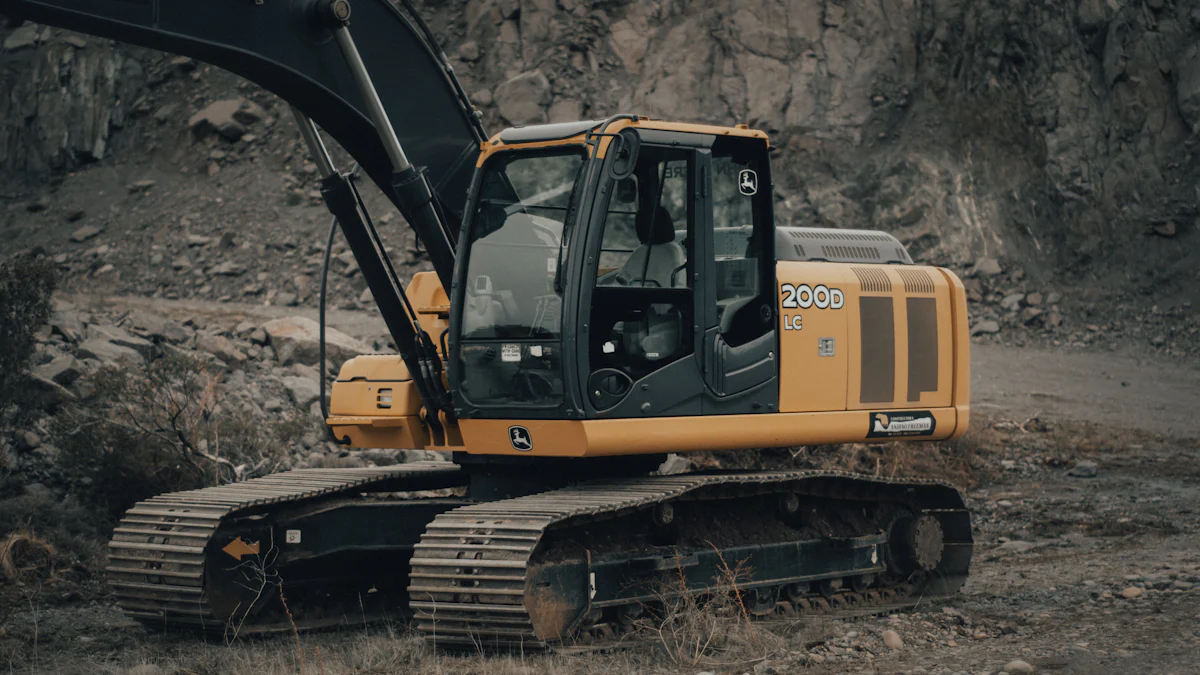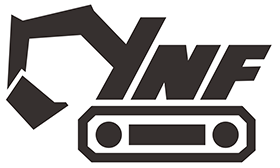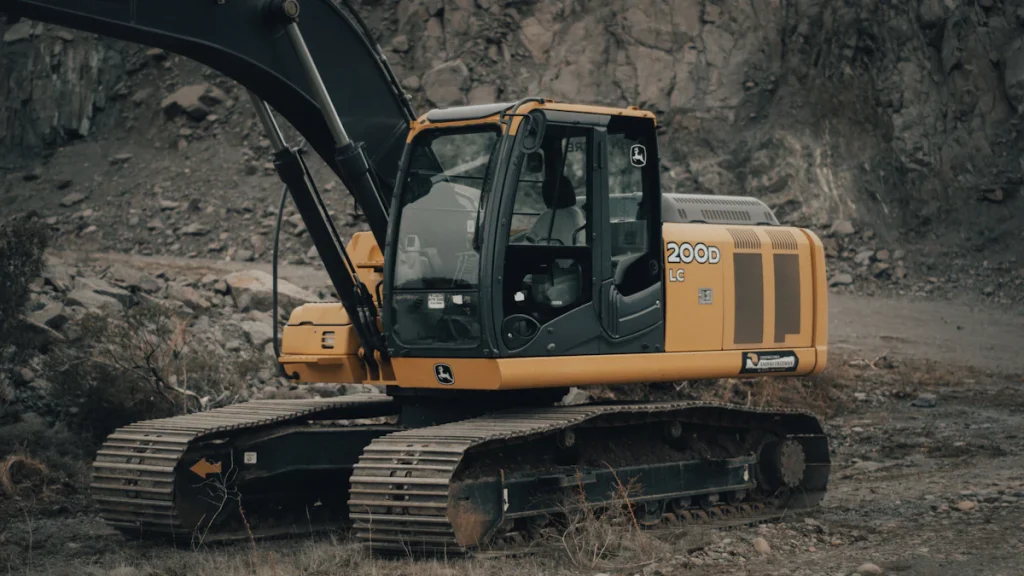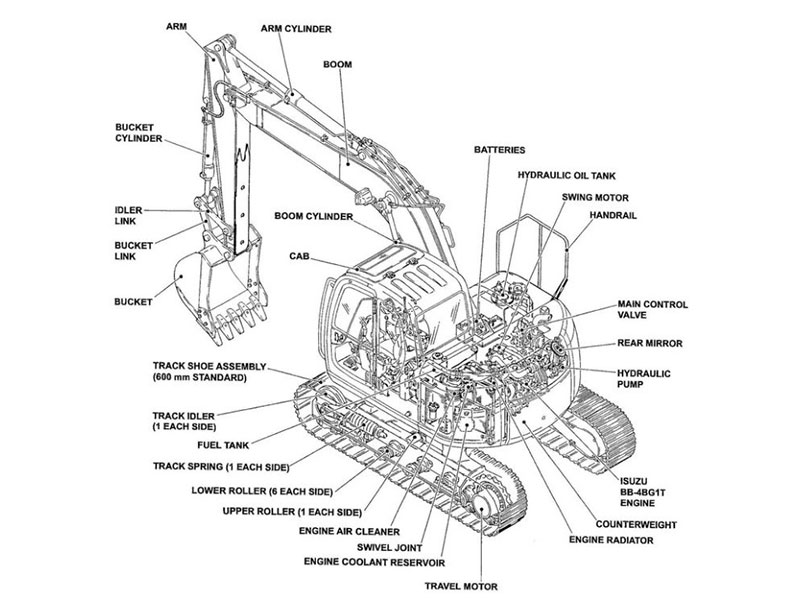
Mini excavators rely on a combination of essential mini excavator parts to perform their tasks efficiently. The undercarriage provides stability and mobility, allowing the machine to navigate various terrains. The cab serves as the control center, housing the operator and critical systems. The arm, boom, and stick work together to handle digging and lifting tasks with precision. The hydraulic system powers these movements, ensuring smooth operation. Each of these mini excavator parts plays a vital role in delivering the specific functions required for construction, agriculture, and other industries.
Key Takeaways
Understanding the essential parts of a mini excavator, such as the undercarriage, cab, and hydraulic system, is crucial for efficient operation and maintenance.
Regular inspections of components like tracks, hydraulic lines, and control valves can prevent unexpected breakdowns and extend the lifespan of your equipment.
Choosing the right type of tracks—rubber for sensitive areas and steel for heavy-duty tasks—can enhance performance and reduce damage to surfaces.
Utilizing attachments like augers, grapples, and breakers allows your mini excavator to tackle a variety of tasks, increasing its versatility on the job site.
Implementing proper maintenance practices, including lubrication and fluid checks, ensures your mini excavator operates smoothly and efficiently.
Safety features such as ROPS and seatbelts are essential for protecting operators; always check these before starting work.
Incorporating quick couplers can significantly reduce downtime by allowing for fast and easy attachment changes, enhancing productivity.
The Undercarriage: Foundation of Mini Excavator Parts
The undercarriage forms the backbone of a mini excavator. It provides stability and mobility, ensuring the machine operates effectively across various terrains. Understanding the components of the undercarriage helps you maintain your equipment and optimize its performance.
Tracks
Tracks are essential for the movement and stability of your mini excavator. They distribute the machine’s weight evenly, reducing ground pressure and minimizing soil disturbance. Tracks come in two main types, each suited for specific applications.
Rubber Tracks
Rubber tracks are ideal for projects in residential areas or sensitive environments. They produce less noise and vibration compared to steel tracks, making them a quieter option. These tracks also reduce wear on paved surfaces, ensuring minimal damage to roads or driveways. If you prioritize efficiency and reduced downtime, consider high-quality rubber tracks like those offered by Fortis HD. These tracks deliver durability and reliability, keeping your mini excavator running smoothly.
Steel Tracks
Steel tracks excel in heavy-duty applications. They are perfect for muddy, rocky, or uneven terrains where durability is crucial. Steel tracks provide excellent traction and stability, even in challenging conditions. Their robust design ensures they withstand the rigors of demanding excavation tasks. For large-scale construction or mining projects, steel tracks are an indispensable choice.
Sprockets and Idlers
Sprockets and idlers play a critical role in the functionality of the undercarriage. Sprockets drive the tracks, ensuring smooth movement and proper alignment. Idlers guide the tracks and maintain tension, preventing slippage during operation. Regular inspection of these components helps you avoid unexpected breakdowns and ensures consistent performance.
Rollers
Rollers support the weight of the excavator and facilitate track movement. They reduce friction between the tracks and the undercarriage, allowing the machine to move efficiently. Properly functioning rollers enhance the stability of your mini excavator, especially on uneven surfaces. Routine maintenance of rollers ensures they remain in optimal condition.
Blade
The blade is a vital component of the mini excavator’s undercarriage. It enhances the machine’s stability and versatility, allowing you to perform tasks like leveling, backfilling, and grading with precision. Understanding the types of blades and their specific functions helps you maximize the efficiency of your mini excavator.
Dozer Blade
The dozer blade is a standard feature on most mini excavators. It serves as a multi-functional tool that supports various operations. You can use it to push soil, level surfaces, or clear debris from your worksite. The dozer blade also acts as a stabilizer, providing additional balance when you operate the arm and boom. Its robust design ensures durability, even in demanding conditions. Regular maintenance of the dozer blade, such as checking for wear and ensuring proper alignment, keeps it functioning effectively.
Stabilizer Blade
The stabilizer blade offers enhanced support during excavation tasks. It minimizes movement and vibration, ensuring precise digging and lifting. This blade is particularly useful when working on uneven or sloped terrains. By anchoring the mini excavator firmly, the stabilizer blade improves safety and operational accuracy. To maintain its performance, inspect the blade regularly for signs of wear or damage. Proper care ensures that the stabilizer blade continues to provide reliable support for your projects.
The Cab: Control Center of Excavator Parts
The cab serves as the command hub of your mini excavator. It houses essential systems and provides you with the tools to operate the machine effectively. A well-designed cab ensures comfort, safety, and precision during operation.
Operator Controls
Operator controls are the primary interface between you and the excavator. They allow you to manage the machine’s movements and functions with ease.
Joysticks
Joysticks are the most intuitive controls in the cab. They help you maneuver the boom, stick, and bucket with precision. Each joystick corresponds to specific movements, enabling you to dig, lift, and position materials accurately. Regular practice with the joysticks improves your efficiency and ensures smooth operation.
Pedals
Pedals in the cab provide additional control over the excavator’s movement. They allow you to manage the tracks and perform auxiliary functions. For example, you can use the pedals to rotate the house or adjust the blade. Keeping the pedals clean and free of debris ensures they respond effectively to your input.
Engine
The engine powers the cab and the entire excavator. It provides the energy needed for digging, lifting, and moving materials.
Diesel Engine
Most mini excavators rely on a diesel engine for their power. Diesel engines deliver high torque, making them ideal for heavy-duty tasks. They ensure consistent performance even in demanding conditions. Regular maintenance, such as oil changes and filter replacements, keeps the engine running efficiently.
Cooling System
The cooling system prevents the engine from overheating. It regulates the temperature, ensuring the engine operates within safe limits. Checking the coolant levels and inspecting the radiator regularly helps you avoid potential issues. A well-maintained cooling system extends the life of your engine.
Safety Features
Safety features in the cab protect you during operation. They minimize risks and ensure a secure working environment.
Rollover Protective Structure (ROPS)
The rollover protective structure (ROPS) is a critical safety feature in the cab. It shields you in case of a rollover, reducing the risk of injury. Always ensure the ROPS is intact and securely fastened before starting the excavator.
Seatbelt and Emergency Stop
The seatbelt keeps you secure in the cab during operation. It prevents you from being thrown forward in case of sudden movements. The emergency stop button allows you to shut down the machine instantly in hazardous situations. Familiarizing yourself with these features enhances your safety and confidence while operating the excavator.
The Arm, Boom, and Stick: Key Digging Functions

The arm, boom, and stick form the core components of your mini excavator’s digging system. These parts work together to deliver precision and power, enabling you to handle a variety of excavation tasks efficiently. Understanding their roles and types helps you maximize the performance of your machine.
Boom
The boom is the primary structure that connects the cab to the stick and bucket. It provides the reach and lifting capability needed for digging and material handling. Choosing the right type of boom ensures that your excavator performs optimally in different working conditions.
Fixed Boom
A fixed boom offers stability and strength. It is ideal for tasks requiring consistent digging depth and reach. This type of boom excels in straightforward excavation projects, such as trenching or foundation digging. Its robust design ensures durability, even in demanding environments.
Swing Boom
A swing boom provides greater flexibility. It allows you to pivot the boom independently of the cab, making it easier to work in tight spaces or around obstacles. This feature is particularly useful for urban construction sites or landscaping projects. With a swing boom, you can position the bucket precisely without moving the entire excavator.
Stick (Arm)
The stick, also known as the excavator stick or arm, connects the boom to the bucket. It extends the reach of the boom and provides the maneuverability needed for precise digging. The length of the stick determines the depth and range of your excavation. A longer stick is suitable for deep digging, while a shorter stick offers better control and lifting power. Regular inspection of the stick ensures it remains in good condition, preventing unexpected downtime.
Bucket
The bucket is the attachment at the end of the stick that performs the actual digging and material handling. Selecting the right bucket for your project enhances efficiency and productivity.
Standard Bucket
A standard bucket is versatile and suitable for general-purpose digging. It handles tasks like soil excavation, material loading, and light grading with ease. Its durable design ensures reliable performance across various applications.
Specialized Buckets (e.g., Trenching, Grading)
Specialized buckets are designed for specific tasks. Trenching buckets have a narrow profile, making them ideal for creating precise trenches for pipelines or cables. Grading buckets feature a wider edge, allowing you to level surfaces and shape landscapes efficiently. Using the appropriate specialized bucket improves accuracy and reduces the time required to complete your project.
Hydraulic Cylinders
Hydraulic cylinders are the driving force behind the movement of your mini excavator’s boom, stick, and bucket. These components convert hydraulic energy into mechanical power, enabling precise and powerful operations. Understanding the role of each cylinder helps you maintain optimal performance and efficiency.
Boom Cylinder
The boom cylinder is responsible for raising and lowering the boom. It provides the lifting power needed to handle heavy loads and reach various heights. This cylinder ensures that the boom moves smoothly and accurately, allowing you to perform tasks like digging trenches or lifting materials with ease. Regular inspection of the boom cylinder for leaks or wear ensures consistent performance and prevents unexpected downtime.
Arm Cylinder
The arm cylinder, also known as the stick cylinder, controls the movement of the stick. It allows you to extend or retract the stick, providing the flexibility needed for precise digging and material handling. The arm cylinder plays a crucial role in determining the depth and reach of your excavation. Keeping this cylinder in good condition ensures that your stick operates efficiently, enhancing the overall functionality of your mini excavator.
Bucket Cylinder
The bucket cylinder powers the movement of the bucket, enabling it to scoop, lift, and dump materials. This cylinder provides the force required for tasks like soil excavation, material loading, and grading. A well-maintained bucket cylinder ensures smooth operation and maximizes the productivity of your mini excavator. Regularly checking for signs of wear or damage helps you avoid disruptions during critical projects.
“Hydraulic cylinders are the backbone of your mini excavator’s digging system. Proper care and maintenance ensure their longevity and reliable performance.”
By understanding the functions of the boom, arm, and bucket cylinders, you can optimize your mini excavator’s capabilities. Regular maintenance and timely repairs keep these hydraulic components in top condition, ensuring efficient and precise operations on every project.
Hydraulic System: Powering Mini Excavator Parts
The hydraulic system is the powerhouse of your mini excavator. It converts mechanical energy into hydraulic energy, enabling precise and powerful movements. Understanding its components ensures you can maintain optimal performance and efficiency.
Hydraulic Pump
The hydraulic pump is the heart of the hydraulic system. It generates the pressure needed to power the excavator’s movements. This pump draws hydraulic fluid from the reservoir and delivers it to the system under high pressure. The pump’s efficiency directly impacts the performance of your mini excavator. Regularly inspecting the pump for leaks or wear ensures consistent operation. A well-maintained hydraulic pump keeps your machine running smoothly, even during demanding tasks.
Hydraulic Lines
Hydraulic lines act as the veins of the hydraulic system. They transport pressurized fluid between the pump, control valves, and cylinders. These lines must withstand high pressure and resist wear to ensure reliable performance. Damaged or leaking hydraulic lines can disrupt the system and reduce efficiency. Inspecting the lines for cracks, leaks, or blockages helps you avoid unexpected downtime. Replacing worn-out lines promptly ensures the hydraulic system operates at peak efficiency.
Control Valves
Control valves regulate the flow of hydraulic fluid within the system. They direct the fluid to specific components, such as the boom, stick, or bucket cylinders. These valves allow you to control the speed and direction of the excavator’s movements. Properly functioning control valves ensure smooth and precise operations. Regular maintenance, including cleaning and calibration, keeps the valves responsive and efficient. Understanding how to adjust the control valves helps you optimize the performance of your mini excavator.
“A well-maintained hydraulic system ensures your mini excavator delivers consistent power and precision, even in challenging conditions.”
By maintaining the hydraulic pump, lines, and control valves, you can extend the life of your mini excavator. Regular inspections and timely repairs keep the hydraulic system in top condition, ensuring reliable performance on every project.
Attachments: Expanding the Functions of Mini Excavators
Attachments enhance the versatility of your mini excavator, allowing you to tackle a wide range of tasks with precision and efficiency. By selecting the right attachment, you can adapt your machine to meet the specific demands of your project. Below are some essential attachments that expand the functionality of your equipment.
Augers
Augers are an essential attachment for drilling holes in the ground. They are commonly used in construction, landscaping, and agricultural projects. With an auger, you can dig holes for fence posts, tree planting, or foundation work. These attachments come in various sizes and designs, enabling you to choose one that matches the soil type and depth requirements of your task.
The auger operates through a hydraulic motor, which powers its rotation. This mechanism ensures consistent performance, even in tough soil conditions. Regular maintenance, such as checking the hydraulic lines and cleaning the auger bit, keeps it functioning effectively. Using an auger attachment saves time and effort, making it an indispensable tool for excavation projects.
Grapples
Grapples are versatile excavator attachments designed for handling materials like logs, rocks, and debris. They feature strong, claw-like arms that grip and lift objects securely. Grapples are ideal for demolition, forestry, and waste management tasks. Their robust design ensures they can handle heavy loads without compromising performance.
Hydraulic cylinders control the movement of the grapple arms, providing precise and powerful gripping action. This allows you to pick up and move materials with ease. To maintain optimal performance, inspect the hydraulic system regularly and ensure the grapple’s teeth remain sharp. A well-maintained grapple attachment enhances your mini excavator’s efficiency and productivity.
Breakers
Breakers, also known as hydraulic hammers, are powerful attachments used for breaking through hard surfaces like concrete, asphalt, and rock. They are essential for demolition and construction projects that require heavy-duty excavation. With a breaker, you can efficiently remove obstacles and prepare the site for further work.
The breaker operates by converting hydraulic energy into mechanical force, delivering high-impact blows to the surface. This makes it a reliable tool for tackling tough materials. To ensure consistent performance, check the hydraulic pump and lines for leaks or wear. Proper care and usage of the breaker attachment extend its lifespan and improve your mini excavator’s capabilities.
“Attachments transform your mini excavator into a multi-functional machine, enabling you to handle diverse tasks with ease and precision.”
By incorporating these front attachments into your mini excavator, you can maximize its potential and adapt it to various applications. Regular maintenance and proper usage of these tools ensure long-lasting performance and efficiency.
Quick Couplers
Quick couplers are essential attachments that enhance the efficiency and versatility of your mini excavator. They allow you to switch between different attachments quickly, saving time and effort on the job site. With a quick coupler, you can adapt your excavator to various tasks without the need for extensive manual adjustments.
Benefits of Quick Couplers
Time-Saving: Quick couplers eliminate the need for tools or lengthy processes when changing attachments. This feature significantly reduces downtime, enabling you to complete projects faster.
Versatility: By using quick couplers, you can seamlessly switch between attachments like buckets, augers, grapples, and breakers. This adaptability makes your mini excavator suitable for a wide range of applications.
Ease of Use: Quick couplers are designed for user convenience. Their intuitive mechanisms ensure that you can attach or detach tools with minimal effort.
Enhanced Safety: Modern quick couplers come with safety features that prevent accidental detachment of attachments during operation. These features provide peace of mind while working on demanding tasks.
Types of Quick Couplers
Manual Quick Couplers: These require some manual intervention to secure or release attachments. They are cost-effective and reliable, making them a popular choice for smaller projects.
Hydraulic Quick Couplers: These couplers use hydraulic power to connect and disconnect attachments. They offer superior speed and convenience, especially for large-scale or time-sensitive projects.
Maintenance Tips for Quick Couplers
To ensure the longevity and performance of your quick coupler, follow these maintenance practices:
Inspect the coupler regularly for signs of wear or damage.
Clean the coupler after each use to remove dirt and debris that may affect its functionality.
Lubricate moving parts to prevent rust and ensure smooth operation.
Check the locking mechanism to confirm it is functioning correctly before starting any task.
“Quick couplers transform your mini excavator into a multi-functional machine, allowing you to tackle diverse tasks with unmatched efficiency.”
By incorporating quick couplers into your equipment, you can maximize productivity and adapt to the unique demands of each project. Proper care and regular inspections will keep your quick coupler in optimal condition, ensuring reliable performance for years to come.
Maintenance Essentials for YNF Machinery Mini Excavator Parts
Proper maintenance ensures your mini excavator operates efficiently and lasts longer. By following essential practices, you can prevent costly repairs and downtime. Below are key maintenance steps to keep your YNF Machinery mini excavator parts in top condition.
Regular Inspections
Frequent inspections help you identify potential issues before they escalate. Examine all critical components, including the undercarriage, hydraulic system, and attachments. Look for signs of wear, cracks, or leaks. Pay close attention to the hydraulic pumps, lines, and control valves, as these are vital for powering the machine’s movements. A malfunction in these parts can significantly impact performance.
Create a checklist for your inspections:
Check the tracks for damage or excessive wear.
Inspect the sprockets, idlers, and rollers for proper alignment.
Examine the hydraulic lines for leaks or blockages.
Verify that the control valves function smoothly.
“Regular inspections not only enhance performance but also extend the lifespan of your mini excavator.”
By staying proactive, you can address minor issues early and avoid unexpected breakdowns.
Lubrication and Fluid Checks
Lubrication reduces friction between moving parts, ensuring smooth operation. Apply high-quality grease to components like the boom, stick, and bucket pins. This practice minimizes wear and tear, keeping your excavator running efficiently.
Hydraulic fluid plays a crucial role in powering the machine. Monitor the fluid levels in the hydraulic tanks regularly. Low fluid levels can lead to reduced efficiency or even damage to the hydraulic cylinders. Use the recommended type of hydraulic fluid to maintain optimal performance.
Steps for effective lubrication and fluid checks:
Clean the grease fittings before applying lubricant to prevent contamination.
Use a grease gun to apply lubricant evenly to all required points.
Check the hydraulic fluid reservoir for adequate levels.
Inspect the fluid for discoloration or contamination, which may indicate the need for replacement.
“Well-lubricated parts and proper fluid levels ensure your mini excavator delivers consistent power and precision.”
Regular lubrication and fluid checks keep your equipment in peak condition, reducing the risk of mechanical failure.
Track Tension Adjustment
Proper track tension is essential for stability and mobility. Tracks that are too loose may slip off, while overly tight tracks can cause excessive wear. Adjusting the track tension ensures smooth operation and extends the life of your undercarriage components.
Follow these steps to adjust track tension:
Park the excavator on a flat surface and lift one side using the blade.
Measure the sag in the track between the sprocket and idler.
Use the adjustment mechanism to tighten or loosen the track as needed.
Recheck the tension to ensure it meets the manufacturer’s specifications.
“Maintaining the correct track tension improves stability and prevents unnecessary wear on your mini excavator.”
Regularly checking and adjusting track tension enhances the machine’s performance, especially on challenging terrains.
By incorporating these maintenance practices into your routine, you can ensure the reliability and efficiency of your YNF Machinery mini excavator parts. Proper care not only boosts performance but also protects your investment for years to come.
Cleaning and Storage
Proper cleaning and storage practices are essential for maintaining the performance and longevity of your mini excavator. By dedicating time to these tasks, you can prevent unnecessary wear, reduce downtime, and ensure your equipment remains in optimal condition.
Cleaning Your Mini Excavator
Dirt, debris, and grease can accumulate on your mini excavator during operation. Regular cleaning not only improves the machine’s appearance but also prevents damage to critical components.
Remove Dirt and Debris
Use a pressure washer or hose to clean the exterior of your excavator. Focus on areas like the undercarriage, tracks, and hydraulic lines, where dirt tends to build up. Avoid directing high-pressure water at sensitive parts, such as electrical connections or hydraulic seals, to prevent damage.Inspect for Grease and Oil Build-Up
Check for grease or oil residue around the boom, stick, and bucket pins. Wipe these areas with a clean cloth to remove excess grease. This step ensures smooth movement and reduces the risk of contamination in the hydraulic system.Clean the Cab Interior
Dust and debris can accumulate inside the cab, affecting operator comfort and visibility. Use a vacuum or soft brush to clean the floor, controls, and seat. Wipe down surfaces with a damp cloth to maintain a clean and safe working environment.Check the Hydraulic System
Inspect the hydraulic lines and control valves for leaks or blockages. Clean these components carefully to ensure the hydraulic fluid flows efficiently. A well-maintained hydraulic system powers the excavator’s movements effectively, enhancing its performance.
“A clean mini excavator operates more efficiently and reduces the likelihood of unexpected breakdowns.”
Storing Your Mini Excavator
Proper storage protects your mini excavator from environmental damage and ensures it is ready for use when needed. Follow these steps to store your equipment safely:
Choose a Suitable Location
Store your mini excavator in a covered area, such as a garage or shed, to shield it from rain, snow, and direct sunlight. If indoor storage is unavailable, use a heavy-duty tarp to cover the machine and protect it from the elements.Prepare the Hydraulic System
Before storage, check the hydraulic fluid levels and top them off if necessary. Ensure the control valves are in the neutral position to relieve pressure in the hydraulic lines. This step prevents strain on the system during extended periods of inactivity.Secure the Tracks and Blade
Position the tracks on a flat surface and lower the blade to the ground. This setup stabilizes the machine and reduces stress on the undercarriage components. For long-term storage, consider loosening the track tension slightly to prevent unnecessary wear.Disconnect the Battery
If you plan to store the excavator for an extended period, disconnect the battery to prevent it from draining. Store the battery in a cool, dry place and charge it periodically to maintain its lifespan.Inspect and Lubricate Moving Parts
Apply a layer of grease to the boom, stick, and bucket pins to protect them from rust. Inspect all moving parts for signs of wear or damage before storage. Address any issues promptly to avoid complications when you resume operation.
“Proper storage practices safeguard your investment and ensure your mini excavator remains in excellent condition.”
By incorporating regular cleaning and proper storage into your maintenance routine, you can extend the life of your mini excavator and keep it performing at its best. These simple yet effective steps protect your equipment and ensure it is always ready for the next project.
Mini excavators are indispensable machines, combining essential mini excavator parts like the undercarriage, cab, arm, boom, stick, and hydraulic system to deliver exceptional performance. Each part plays a unique role, from the cab acting as your control hub to the hydraulic system powering precise movements. Understanding these excavator parts helps you operate efficiently and maintain your equipment effectively. YNF Machinery offers high-quality mini excavator parts, ensuring durability and reliability for your projects. With the right parts and maintenance, your mini excavator can handle diverse tasks with ease and precision.
FAQ
What are the essential parts of a mini excavator?
A mini excavator consists of several key components, including the undercarriage, cab, arm, boom, stick, bucket, and hydraulic system. Each part plays a specific role in ensuring the machine operates efficiently. For example, the undercarriage provides stability and mobility, while the hydraulic system powers the movements of the boom, stick, and bucket.
How do quick couplers enhance mini excavator functionality?
Quick couplers allow you to switch between attachments quickly and efficiently. They eliminate the need for manual labor to secure or release attachments, saving time and effort. With quick couplers, you can easily transition between tasks like digging, grading, or drilling. This feature makes your mini excavator more versatile and adaptable to various projects.
What types of quick couplers are available?
Quick couplers come in two main types:
Manual Quick Couplers: These require you to manually lock and unlock the attachment. They are cost-effective and suitable for smaller projects.
Hydraulic Quick Couplers: These use hydraulic power for attachment changes, offering faster and more convenient operation. They are ideal for large-scale or time-sensitive tasks.
Both types improve efficiency, but hydraulic quick couplers provide greater ease of use.
How can I maintain the hydraulic system of my mini excavator?
To keep the hydraulic system in top condition:
Inspect hydraulic lines regularly for leaks or blockages.
Check the hydraulic fluid levels and ensure they meet the recommended standards.
Clean the control valves and ensure they function smoothly.
Replace worn-out components promptly to avoid disruptions.
Proper maintenance ensures consistent power and precision during operation.
What is the purpose of the boom, stick, and bucket?
The boom, stick, and bucket form the core digging system of a mini excavator:
Boom: Provides reach and lifting capability.
Stick (Arm): Extends the boom’s reach and offers maneuverability.
Bucket: Performs digging, scooping, and material handling tasks.
These components work together to deliver precise and efficient excavation.
Why are rubber tracks preferred for certain projects?
Rubber tracks are ideal for residential or sensitive environments. They produce less noise and vibration, reducing wear on paved surfaces. Rubber tracks also minimize soil disturbance, making them suitable for landscaping or urban construction projects. Their durability and quiet operation make them a popular choice for many operators.
How do I choose the right attachment for my mini excavator?
Selecting the right attachment depends on your project requirements:
Use augers for drilling holes in the ground.
Choose grapples for handling logs, rocks, or debris.
Opt for breakers to break through concrete or rock.
Select grading buckets for leveling surfaces.
Quick couplers make it easier to switch between these attachments, enhancing your excavator’s versatility.
What safety features should I check before operating a mini excavator?
Ensure the following safety features are functional:
Rollover Protective Structure (ROPS): Protects you in case of a rollover.
Seatbelt: Keeps you secure during operation.
Emergency Stop Button: Allows you to shut down the machine instantly in hazardous situations.
Regularly inspect these features to maintain a safe working environment.
How often should I inspect my mini excavator?
You should perform regular inspections before and after each use. Focus on critical components like the undercarriage, hydraulic system, and attachments. Look for signs of wear, cracks, or leaks. Frequent inspections help you identify potential issues early and prevent costly repairs.
What are the benefits of using YNF Machinery parts for mini excavators?
YNF Machinery offers high-quality mini excavator parts designed for durability and reliability. Their products undergo rigorous quality inspections to ensure optimal performance. By choosing YNF Machinery parts, you can enhance the efficiency and longevity of your mini excavator, ensuring it performs well across various projects.





